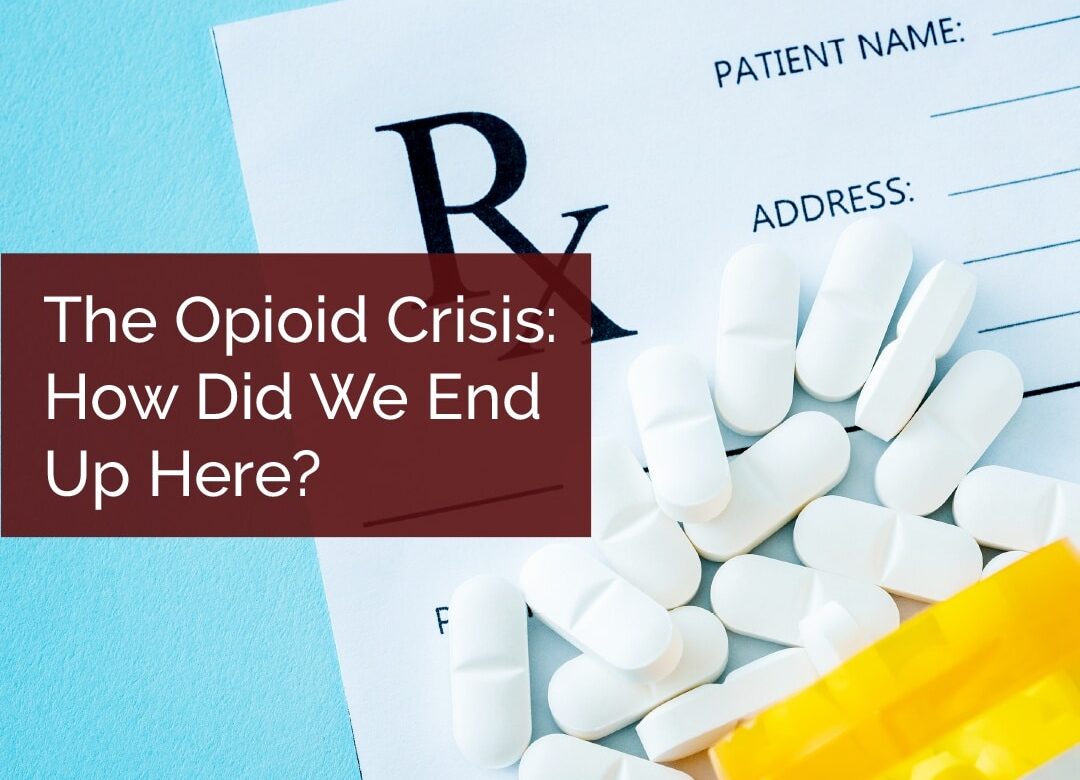section-02280fe
The Opioid Crisis: How Did We End Up Here?
 Bottom Line:
Bottom Line:
If you make it a habit to watch the news, you’ve probably wondered on more than one occasion “How did the opioid crisis start?”
Well, the answer might surprise you.
About 30 years ago, there was a fundamental shift in medicine regarding how pain was understood and treated.
The number of people with chronic pain seemed to be rising, and it was thought that the options to address the pain weren't adequate.
Why it Matters:
As doctors paid more attention to assessing pain, they also paid more attention to treating pain.
Enter opioids.
Opioid medications began to be prescribed more and more frequently for chronic low back or neck pain.
Surprisingly, up until then, opioids were only prescribed for severe pain after surgery or advanced-stage cancer.
But that all changed in the early 1990’s.
New opioids formulas were promoted as being less addictive, and physicians were encouraged to prescribe these drugs far more liberally than before, including for the care of chronic pain.
Prescribing these drugs very quickly created and exposed a number of problems.
Healthcare professionals noted how rapidly patients adapted to the drugs, meaning larger and larger doses had to be prescribed to sustain those promised pain suppressing effects as time went on.
That, of course, indicated these drugs weren't very effective at addressing chronic pain.
They provided short-term relief, but they seemed to become less useful for many people as time went on.
What’s more, the euphoric feelings often associated with these drugs put it’s users at a high risk for addiction.
Next Steps:
Now, some 30-odd years later, we are witnessing an opioid crisis.
If there is a silver lining to be found, we as a collective now realize that the answers and treatment of chronic pain are rarely found in a bottle.
Many leading healthcare organizations are now recommending non-pharmacological approaches to treating chronic pain including chiropractic.
If you would like to explore a drug-free approach to pain relief, schedule an appointment with us today.
As the leading natural pain doctor in Singapore, we have the tools and know how you’ve been looking for.
Our doors are always open, and we’re here to help!
Science Source(s):
section-c39e138
The Chronic Pain Crisis is the Opioid Crisis
 Bottom Line:
Bottom Line:
For decades, opioids were marketed as a "safer" alternative to treat chronic pain.
And as the number of people seeking care for chronic pain began to rise, so did the number of people filling prescriptions for highly addictive opioids.
If you’ve ever wondered “What is the opioid crisis?” - that’s the simple answer.
However, what many don’t realize is that what we currently refer to as the opioid crisis started as a chronic pain epidemic.
Why it Matters:
Over the past few years, major healthcare agencies have recognized that non-pharmacological approaches should be the first line of care to manage chronic pain.
The best way to combat the opioid crisis is to focus on non-pharmacological solutions to the chronic pain epidemic.
And recent studies have indicated that there are more than a few reasons to be hopeful.
These studies have shown that non-drug treatment options, such as chiropractic, can be very effective at helping people reduce the development and recurrence of chronic pain.
Even study participants with severe chronic pain reported experiencing significant benefits from the chiropractic care they received.
Next Steps:
While we can't undo the damage that has been done, we can learn from the past.
This recent and unprecedented shift to a primarily non-pharmacological based approach to pain management is a start.
And if you’ve been looking for a pain chiropractor in Singapore, look no further.
Our practice is proud to partner with other healthcare providers who support a natural approach to pain management.
We’ll work together to overcome your chronic pain without the dangerous side effects and addiction issues others have experienced with opioid medications.
Science Source(s):
Prevalence of Chronic Low Back Pain. Rev Saude Publica. 2015.
Chiropractic for Low-Back Pain. J Altern Complement Med. 2008.
section-3c1165d
Opiates vs. Opioids: What’s the Difference?
 Bottom Line:
Bottom Line:
Opiates vs. opioids - while they come from different sources, they are similar in a very specific way.
Both opioids and opiates have caused millions of people looking for pain relief to enter a cycle of addiction.
And the truth is that many of the people who are currently addicted to opioids weren’t recreational drug users looking for their next high…
They were people who were prescribed these drugs by their doctors to treat their chronic pain.
Why it Matters:
To understand more about how this addiction epidemic happened, it's helps to understand the differences between opioids and opiates.
Opiates describe drugs derived from the flowering opium poppy plant.
Morphine is an example of an opiate.
These drugs have been linked to physical dependence, increased tolerance, and addiction.
Opioids are synthetic or made in a lab.
When opioid receptors in the brain become activated, they produce feelings of pleasure and pain (all opioid drugs act on these receptors).
Some are up to 50 times more powerful than heroin.
It goes without saying that these drugs are highly addictive and dangerous.
Opioid drugs used to treat pain include oxycodone and hydrocodone.
Oxycodone exhibits the highest risk of abuse and poses the most significant dangers.
It affects the nervous system in the same way as heroin.
Next Steps:
Current medical guidelines no longer recommend the use of opioids for most spinal pain.
If you're struggling with pain, movement-based care, like chiropractic, is often the best way to accelerate the healing process and put yourself in a position for long-term relief.
Both the research and results we’ve seen at our drug-free pain management clinic Singapore don’t lie.
Call us today if you want to explore a relief path that doesn't include medications.
Science Source(s):
Chiropractic for Treatment of Low Back Pain. JMPT. 2018.
Understanding the Opioid Overdose Epidemic. CDC. 2022.
section-c05ea0b
Beyond the Pill: Non-Opioid Care for Chronic Pain
 Bottom Line:
Bottom Line:
If you're dealing with chronic pain, now is the time to tackle it naturally.
But how do you deal with chronic pain without using opioid pain medication?
Are opioid alternatives for pain management actually effective?
Allow us to answer that with a resounding YES!
One of the problems with pain medications is that they only treat the symptoms - they aren't doing a thing to resolve the source of your pain.
If you are looking for a long-term solution, the cause needs to be addressed.
Altered biomechanics, or movement patterns, tend to be a common issue for many people dealing with chronic spine pain.
Why it Matters:
To get things moving on the path towards relief, we have found a lot of success with a plan that typically encourages a couple of core components.
First, we incorporate whole body movement with daily exercise.
It may seem impossible to get out and get active when you're dealing with chronic pain, but it may help you see some relief from your symptoms! For example, if you're dealing with chronic back pain, regular walks can help relieve the stiffness and soreness of back pain.
Next, we add specific, targeted chiropractic adjustments.
Chiropractors are an excellent resource for anyone who is dealing with chronic pain.
New research has shown chiropractic care is at least as effective at relieving pain as many medications, without the risks or dangers associated with drugs.
The likelihood of filling an opioid prescription is reduced by over 50% for people who see a chiropractor.
Next Steps:
You don't need to keep struggling with chronic pain.
Researchers have found that chiropractic care and targeted active exercise can effectively address the cause of your pain to best reduce your symptoms.
If you or someone you know has struggled with chronic pain, please reach out to us at our holistic pain management clinic in Singapore today.
Our expert team is standing by to help provide you with options for relief that don't include the dangerous medications that have created the current opioid epidemic.
Science Source(s):
Chiropractic for Treatment of Low Back Pain. JMPT. 2018.
Understanding the Opioid Overdose Epidemic. CDC. 2022.
Impact of Chiropractic on Use of Opioids. Pain Med. 2020.









